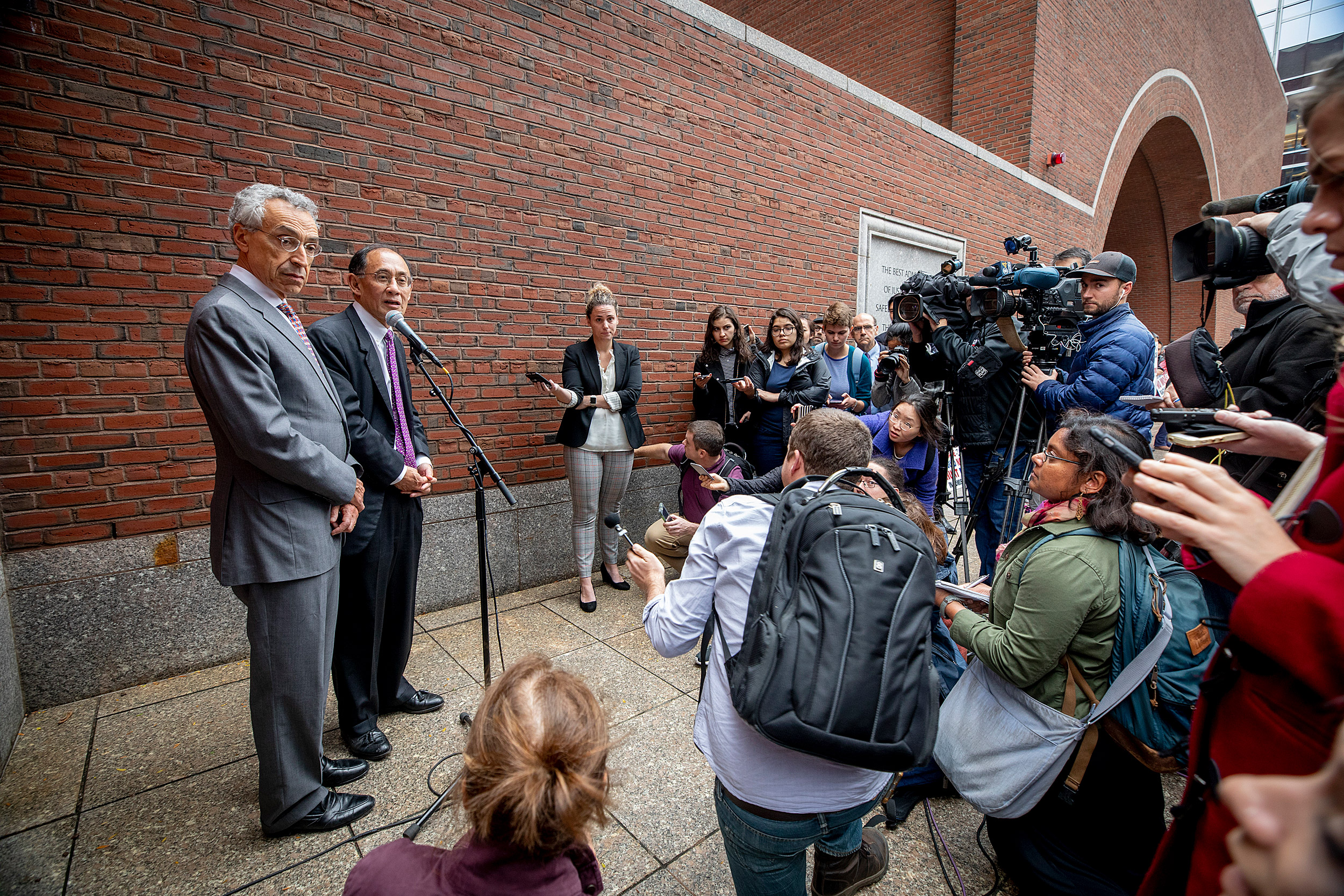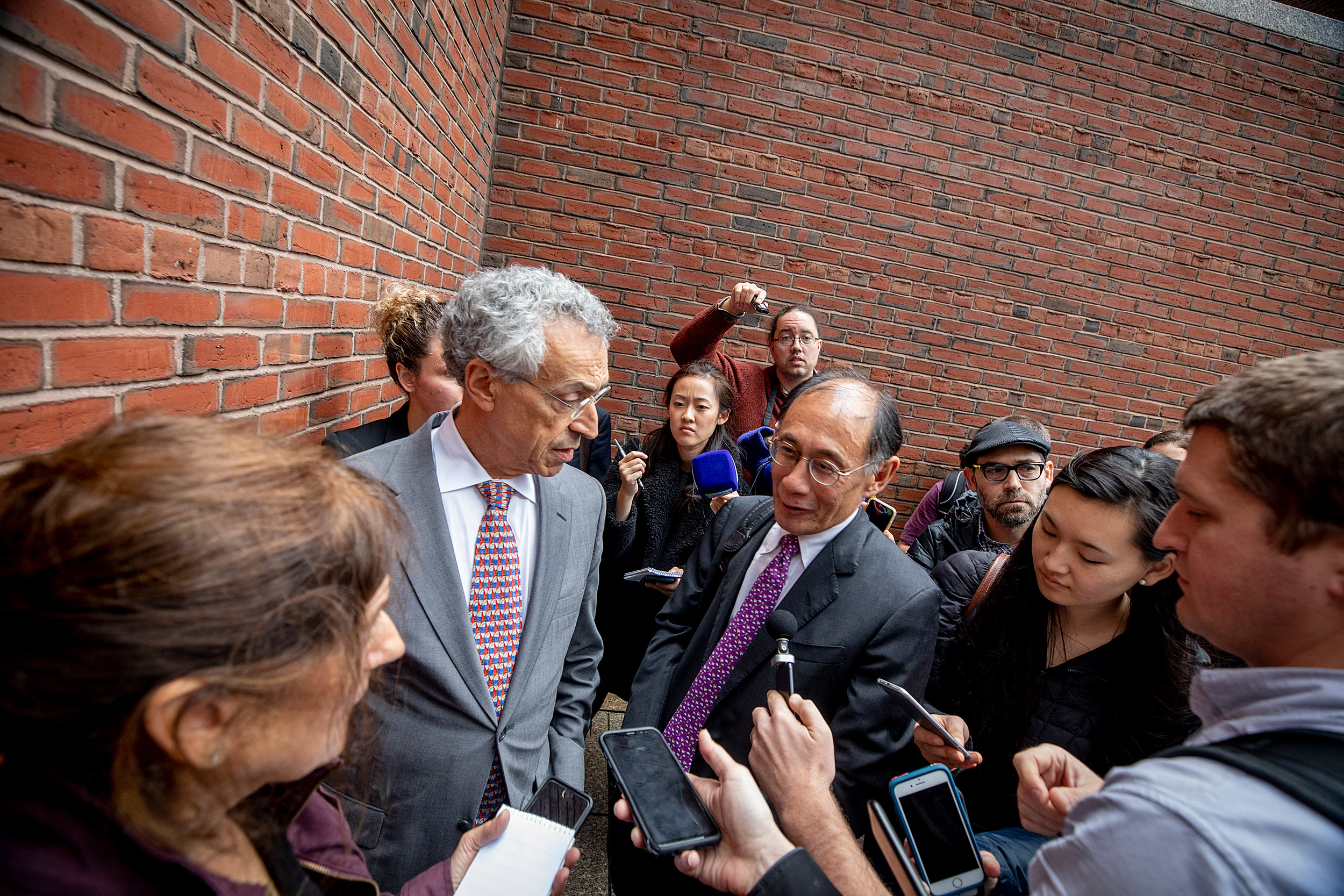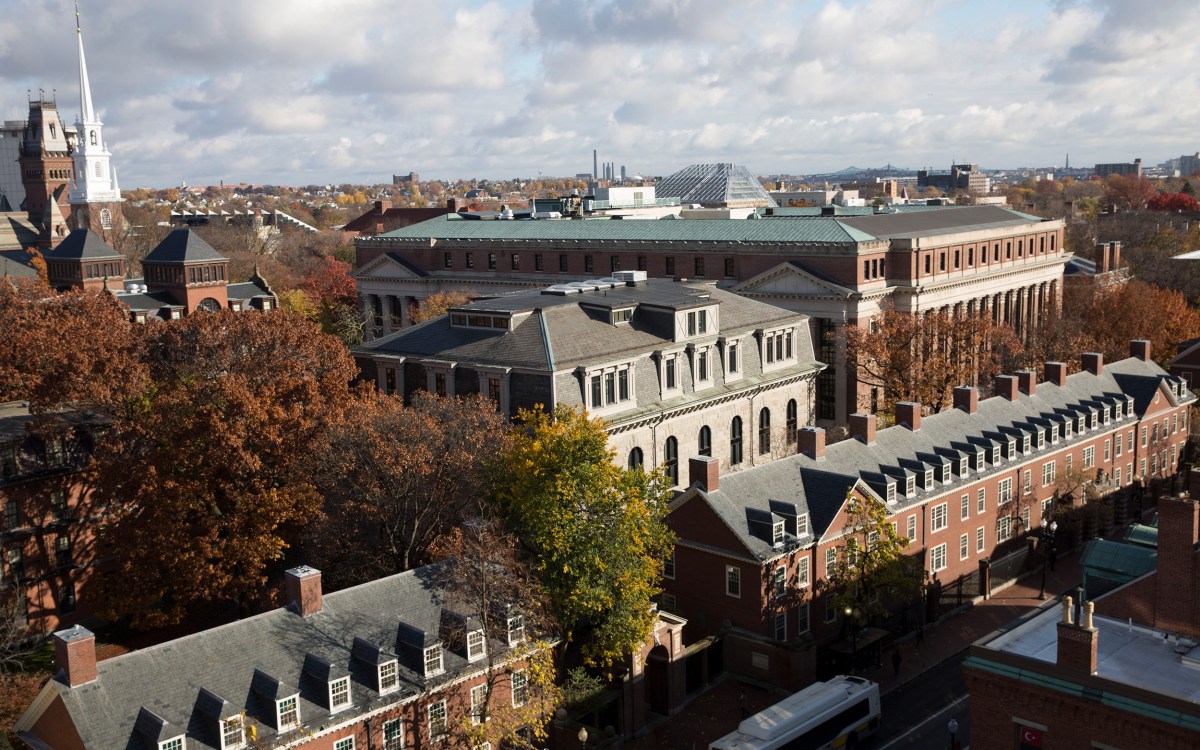
Harvard’s lead trial attorney William F. Lee ’72 (right) and co-counsel Seth Waxman ’73 answer questions in front of the Moakley U.S. Courthouse following the conclusion of the trial on Friday.
Rose Lincoln/Harvard Staff Photographer
Attorney appears confident admissions case ruling will favor Harvard
William Lee says he expects judge will find that College does not discriminate against Asian Americans
Attorney William F. Lee ’72 stood outside Boston’s Moakley U.S. Courthouse Friday afternoon and appeared confident a federal judge will rule that Harvard does not discriminate against Asian Americans in its admission practices.
Surrounded by reporters, the University’s lead trial lawyer said that Harvard “does not discriminate” and that a contrary ruling would be counter to established legal precedent, would eliminate 1,000 Hispanic and African-American students from Harvard’s campus, and would be “a disaster for the country.”
The trial, which concluded with lawyers from Harvard and the group Students for Fair Admissions (SFFA) offering closing statements, was the culmination of a lawsuit filed by that group in 2014. Founded by Edward Blum, an opponent of race-conscious admissions, SFFA alleges that Harvard discriminates against Asian Americans in its College admissions.
Harvard has denied the claims and said its process, which has been cited by the Supreme Court as an exemplar, uses race as one consideration among many when selecting among thousands of highly qualified applicants for its first-year class. A race-neutral policy, Harvard contends, would severely curtail the diversity of its student body.
As he did in his opening statement, Lee again recalled a day early in his legal career when he was one of only two minorities in a courtroom filled with white men. Society, like Harvard, has made great strides toward inclusion and diversity in the intervening 42 years, said Lee, and a ruling in SFFA’s favor would threaten that critical progress.
“The demographics of those here with us today as this trial ends reflect the enormous progress we have made in becoming a more diverse and inclusive society and community. The plaintiff wants to turn back that clock. The plaintiff thinks, as they told us under oath, in terms of the efficient allocation of minority students and winners and losers,” said Lee, saying that according to SFFA’s expert economist, Duke University’s Peter Arcidiacono, Asian American and white students would be the “winners,” while Hispanic and African-American students would be the “losers” under race-neutral admissions.
In his closing remarks, co-counsel for Harvard Seth Waxman ’73 addressed the statistical model that SFFA used to argue that Asian American applicants are penalized. He said key flaws in the design created by Arcidiacono rendered it moot, and SFFA’s argument baseless. Arcidiacono’s decision to leave out important information from his model amounted to data mining, said Waxman, that “took him further and further away from Harvard’s actual process. He made the choices that instead allowed him to find the result the plaintiff was looking for.”
Assessing the numbers
Many analysts and scholars agree the ruling will likely turn in part on how Judge Allison D. Burroughs interprets the testimony offered by each side’s statistical experts. Arcidiacono and Harvard’s expert, David Card, a professor at the University of California, Berkeley, who specializes in labor economics, each completed complex statistical analyses using six years of admissions information representing more than 100,000 applications.
During the second and final weeks of the trial, both experts spent several hours on the stand explaining their approaches in exacting detail. Arcidiacono told his lawyers that, based on his model, which intentionally left out athletes, children of Harvard alumni, students on the dean’s interest list, or children of Harvard faculty or staff, he found evidence of discrimination against Asian Americans. Arcidiacono said his decision to omit those applicants allowed him to compare “apples to apples” since those applicants are accepted at a higher rate than others in the pool.

Under questioning from Harvard and SFFA lawyers, Card pushed back, saying that Arcidiacono’s data was incomplete because it failed to reflect important information considered by the admissions office, such as an applicant’s intended concentration, parental occupation, results of the alumni interview, and personal rating. Card also criticized the Duke professor’s choice to leave some applicants out of his analysis, saying the exclusions made Arcidiacono’s results unreliable.
“Excluding this highly competitive group, who are 30 percent of the admissions, in my mind would be kind of like estimating a model for retirement and excluding all the people over 65,” said Card.
In his model, Card said he chose to include that information and also to run a separate model for each year of data instead of pooling all years into one model as Arcidiacono had done, in an effort to match Harvard’s actual process more effectively. He said his results showed no discrimination in admissions.
Card said his model showed a slight advantage for Asian American female applicants, and Asian Americans who applied from California. Waxman pointed out that inconsistency, saying such findings “would surely be a bizarre outcome for an admissions office trying to discriminate against Asian Americans.”
Lawyers for Harvard also cited an amicus brief field by 16 economists, including two Nobel laureates and former chair of the Federal Reserve Janet Yellen, who backed Card’s approach and labeled Arcidiacono’s findings “implausible.”
Harvard faculty, staff, students, leaders testify
Over 15 days of proceedings, numerous current and former Harvard officials, students, and staff took the stand in support of Harvard. Longtime Dean of Admissions William R. Fitzsimmons ’67 spent four days offering testimony and walking lawyers through the complicated process of how admissions officers select students for an incoming class. The ultimate decisions, said Fitzsimmons, are the result of countless hours of work by individuals and a 40-person committee review. An applicant’s race or ethnicity, he said, is only one of many factors taken into consideration throughout the process.
Asked by Lee if, in his more than 30-year career with the admissions office, he had seen “bias or discrimination against Asian Americans,” Fitzsimmons replied: “Never.”
Former Harvard President Drew Faust, who led the University when the suit was filed, testified that Harvard’s diverse campus helps the institution fulfill its mission of fostering a “diverse learning environment” where “intellectual transformation is deepened and conditions for social transformation are created.”
Faust, who led a number of efforts to promote diversity and inclusion during her tenure, told Lee, “Racial diversity is important because race is an element in our society of importance, and it also can be a defining element in how our students understand themselves and how they understand the experiences of their lives and what they bring to the Harvard College community.”
Ruth Simmons, former president of Brown University, also testified. Simmons, who was born in Texas in a sharecropper’s shack, said the deep divisions in American society require leaders who are prepared to break down barriers and to mediate conflicts. Absent its diversity, Harvard’s goal of educating citizen-leaders “would be an impoverished mission that does not provide for its students the kind of education that prepares them to live in the world that we now have,” she said.
Current, former students tell their stories
The most moving testimony came early last week when several current and former students took the stand. The eight undergraduates and alumni, representing a range of backgrounds and life experiences, testified it was critical for Harvard to continue to use race as a factor in its admissions processes, both to attract diverse applicants and to maintain a diverse student body.
Sally Chen, a Harvard senior who identifies as Chinese American, said her parents were warehouse and factory workers before they immigrated to the U.S. in 1980. Chen said she frequently acted as a translator for them and advocated “for them across barriers of cultural and linguistic difference in different settings.” Those efforts, she said, helped shape her views on social responsibility and her desire to advocate for others, and they became the focus of her Harvard application essay.
Chen reviewed her admission file after she was accepted. She told the court, “I was, I think, very much seen, and my story was heard … and I think that there was no way in which flat numbers and a resume could have gotten across how much of a whole person that I am. And I think that it’s truly incredible to have been seen and been heard for who I am and valued for it.”
Some witnesses testified that Harvard’s diversity helped inspire them to apply.
Itzel Libertad Vasquez-Rodriguez, who graduated cum laude from Harvard in 2017 with a sociology concentration, said Harvard wasn’t on her radar when she began her college search. “I thought it was a school that was too white, that was too elite,” said Vasquez-Rodriguez.
But she later became intrigued, she said, by the possibility of learning alongside the “best and brightest students in the world” and from the “best professors.” As someone who identifies as Chicana and hails from “a diverse area in Southern California,” Vasquez-Rodriguez said she was also impressed by the fact that Harvard valued diversity and considered race as one of many factors in its application process.
“I felt like so much of my experience and so much of my perspective and world view has been colored by my ethno-racial identity, and I wanted a school that took that into consideration and that valued that — that part of myself. And I also wanted to make sure that there would be other students who were people of color like myself who would be at that school so that I could have a more safe environment, a more welcoming environment,” and a better learning environment.
In his closing statement, Lee highlighted the Harvard students who had testified, projecting their images on a slide. “In contrast to all of this, what did you hear from SFFA?” asked Lee whose next slide was blank. “Not a single member of SFFA took the stand.” The identities of SFFA’s student members have not been made public.
Views from Harvard students
As they had through much of the trial, Harvard students filled the seats in the back of the courtroom on the final day. Those unable to get in watched the proceedings on monitors in an empty jury room on the second floor.
Catey Boyle mingled with friends outside the courthouse after the trial ended. A Harvard Ph.D. student in history and a member of the Kuumba Singers of Harvard College, a group that was part of an amicus brief filed on behalf of Harvard, Boyle said she was there to show her support.
“I came because affirmative action matters and race-conscious admissions matter, not just for students of color but also for white students as well,” said Boyle. “It broadens our experience and makes the education better when you interact with people from different backgrounds. And I wanted to be present and show who this is going to affect. It’s going to affect all Harvard students.”
Nearby, lawyers for SFFA held their own press conference, as Blum looked on from behind reporters flanked by protestors holding signs that read “Harvard Stop Asian Quota.”
“We are committed to this case until the end,” said SFFA lawyer William S. Consovoy.
A ruling in the case is expected in the coming months. But regardless of Burroughs’ decision, many analysts think the U.S. Supreme Court will ultimately have the final word.








